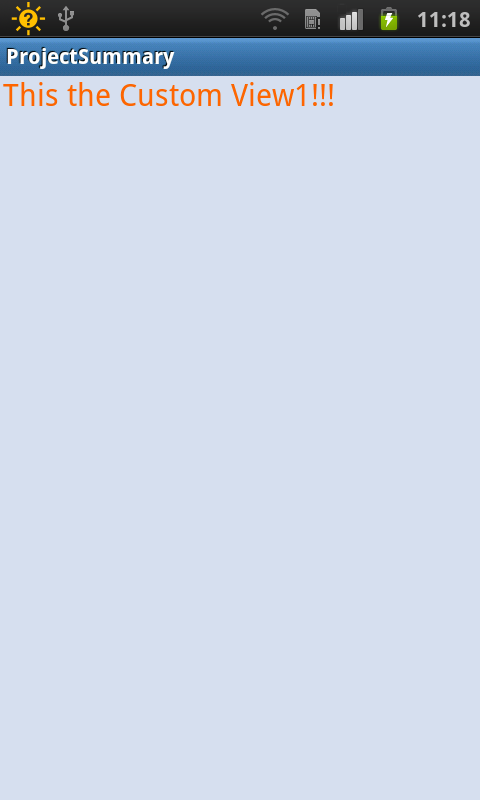Android 自定义View及其在布局文件中的使用示例(二)
转载请注明出处
http://www.cnblogs.com/crashmaker/p/3530213.html
From crash_coder linguowu
linguowu0622@gamil.com
前言:上一篇中(Android 自定义View及其在布局文件中的使用示例)介绍了Android开发中,当系统提供的控件不满足开发者需求的时候,演示如何自定义View,本文将作为上篇的延续,先大体上介绍Android是如何画出界面的,属于前提理论基础,下一篇将重点介绍Android画界面过程中的几个重要方法,如:
1,onMeasure()
2,onLayout()
3,onDraw()
Android绘图的理论基础:
1,我们创建一个Activity来测试上一篇中自定义的View:
a)
CustomViewActivity.java
public class CustomViewActivity extends Activity{
@Override
protected void onCreate(Bundle savedInstanceState) {
// TODO Auto-generated method stub
super.onCreate(savedInstanceState);
setContentView(R.layout.customview_layout);
}
}
b)
customview_layout.xml
<?xml version="1.0" encoding="utf-8"?>
<LinearLayout xmlns:android="http://schemas.android.com/apk/res/android"
xmlns:app="http://schemas.android.com/apk/res/com.project.summary"
android:layout_width="match_parent"
android:layout_height="match_parent"
android:background="@color/BgColor"
android:orientation="vertical" > <com.project.summary.customview.CustomView
android:id="@+id/customView"
android:layout_width="wrap_content"
android:layout_height="wrap_content"
app:colorValue="@color/textRed"
app:textSize="20sp"
app:textString="This the Custom View1!!!" /> </LinearLayout>
c)运行结果:

2,Android是如何实现上图的效果的呢?
a)
查看google文档,它给出了如下解释:
When an Activity receives focus, it will be requested to draw its layout. The Android framework will handle the procedure for drawing, but the Activity must provide the root node of its layout hierarchy.
结合上面的例子来说明一下:当进入CustomViewActivity这个Activity时,该Activity获得焦点,此时,该Activity就会向系统请求绘制出它的布局,这个请求通过Android framework来处理,前提是:CustomViewActivity必须提供该布局的根结点,从CustomViewActivity.java看出,该Activity提供了R.layout.customview_layout,而该布局的根结点就是我们布局文件的LinearLayout;
b)
Drawing begins with the root node of the layout. It is requested to measure and draw the layout tree. Drawing is handled by walking the tree and rendering each View that intersects the invalid region. In turn, each ViewGroup is responsible for requesting each of its children to be drawn (with the draw() method) and each View is responsible for drawing itself. Because the tree is traversed in-order, this means that parents will be drawn before (i.e., behind) their children, with siblings drawn in the order they appear in the tree.
从该段文档可以了解到,Android中View的绘制是从布局的根结点开始,开始之前需要遍历整个布局结构,如果是ViewGroup,ViewGroup(如:LinearLayout,RelativeLayout等)需要对它的所有子View进行遍历及绘制,如果只是普通的View(TextView等),那么它只负责对自身进行绘制。
c)
Drawing the layout is a two pass process: a measure pass and a layout pass. The measuring pass is implemented in measure(int, int) and is a top-down traversal of the View tree. Each View pushes dimension specifications down the tree during the recursion. At the end of the measure pass, every View has stored its measurements. The second pass happens in layout(int, int, int, int)and is also top-down. During this pass each parent is responsible for positioning all of its children using the sizes computed in the measure pass.
绘制需要两个过程,一个是measure(测量大小的)过程,一个是layout(计算绘制位置的)过程:
1)measure过程:需要在measure()方法中实现,并且是自顶向下地遍历测量View的树形结构,测量完后,各结点将它的测量规格(specifications)存放在该树形结构中;
2)layout过程:通过调用layout(int,int,int,int)方法,每一个父View负责子View的绘制位置,而子View的最终大小,则是通过measure过程计算出来的大小。
d)
When a View object's measure() method returns, its getMeasuredWidth() and getMeasuredHeight() values must be set, along with those for all of that View object's descendants. A View object's measured width and measured height values must respect the constraints imposed by the View object's parents. This guarantees that at the end of the measure pass, all parents accept all of their children's measurements. A parent View may call measure() more than once on its children. For example, the parent may measure each child once with unspecified dimensions to find out how big they want to be, then call measure() on them again with actual numbers if the sum of all the children's unconstrained sizes is too big or too small (that is, if the children don't agree among themselves as to how much space they each get, the parent will intervene and set the rules on the second pass).
当每个View对象的measure()方法返回时,每个View的测量宽度值跟测量高度值必须已经被设置,且这两个值是与该View对象的父View相互作用下得来的,并不是说每个View对象都能请求到它任意想得到的值,如果这个View对象请求的宽度或者高度不合理,那么,这个View对象的父View,将再次调用measure()方法,再次确定这个View对象的最终宽度和高度,这个将在后面的onMeasure()过程详细说明中解释;
e)
The measure pass uses two classes to communicate dimensions. The ViewGroup.LayoutParams class is used by View objects to tell their parents how they want to be measured and positioned. The base ViewGroup.LayoutParams class just describes how big the View wants to be for both width and height. For each dimension, it can specify one of: 1)an exact number:
2)MATCH_PARENT:
which means the View wants to be as big as its parent (minus padding)
3)WRAP_CONTENT:
which means that the View wants to be just big enough to enclose its content (plus padding).
There are subclasses of ViewGroup.LayoutParams for different subclasses of ViewGroup. For example, RelativeLayout has its own subclass of ViewGroup.LayoutParams, which includes the ability to center child View objects horizontally and vertically. MeasureSpec objects are used to push requirements down the tree from parent to child. A MeasureSpec can be in one of three modes: UNSPECIFIED: This is used by a parent to determine the desired dimension of a child View. For example, a LinearLayout may call measure() on its child with the height set to UNSPECIFIED and a width of EXACTLY 240 to find out how tall the child View wants to be given a width of 240 pixels.
EXACTLY: This is used by the parent to impose an exact size on the child. The child must use this size, and guarantee that all of its descendants will fit within this size.
AT MOST: This is used by the parent to impose a maximum size on the child. The child must guarantee that it and all of its descendants will fit within this size.
测量过程使用两个类与dimensions(尺寸)进行通讯,这两个类分别是ViewGroup.LayoutParams和MeasureSpec
ViewGroup.LayoutParams:
用来让View对象告诉他的父View,它需要如何被测量和放置在什么位置,然而,ViewGroup.LayoutParams只是单方面地描述它自己想要多大的宽度和高度而已,并不是最终绘制出来的宽度和高度,ViewGroup.LayoutParams可以指定为以下的值:
1)an exact number:
具体的数值;
2)MATCH_PARENT:
与父容器一样的大小;
3)WRAP_CONTENT:
本身该多大就多大,根据该View的内容而定,如TextView中,如果将其宽度设置为wrap_content,那么,它将随着text的长度而改变它的宽度。
MeasureSpec:
该对象封装了父容器传递给子元素的布局要求,它有三种模式:
1)
UNSPECIFIED:父容器对子元素没有要求,子元素可以得到任意值;
2)
EXACTLY:父窗口决定子元素的大小,子元素将被限定在给定的边界里而忽略它本身大小;
3)
AT MOST:子元素至多达到父窗口指定的大小,子元素不能超过这个边界;
Android 自定义View及其在布局文件中的使用示例(二)的更多相关文章
- Android 自定义View及其在布局文件中的使用示例(三):结合Android 4.4.2_r1源码分析onMeasure过程
转载请注明出处 http://www.cnblogs.com/crashmaker/p/3549365.html From crash_coder linguowu linguowu0622@gami ...
- Android 自定义View及其在布局文件中的使用示例
前言: 尽管Android已经为我们提供了一套丰富的控件,如:Button,ImageView,TextView,EditText等众多控件,但是,有时候在项目开发过程中,还是需要开发者自定义一些需要 ...
- Android查缺补漏(View篇)--布局文件中的“@+id”和“@id”有什么区别?
Android布局文件中的"@+id"和"@id"有什么区别? +id表示为控件指定一个id(新增一个id),如: <cn.codingblock.vie ...
- android 布局文件中xmlns:android="http://schemas.android.com/apk/res/android"
http://blog.163.com/benben_long/blog/static/199458243201411394624170/ xmlns:android="http://sch ...
- Android自定义View初步
经过上一篇的介绍,大家对于自定义View一定有了一定的认识,接下来我们就以实现一个图片下显示文字的自定义View来练习一下.废话不多说,下面进入我们的正题,首先看一下我们的思路,1.我们需要通过在va ...
- android自定义view系列:认识activity结构
标签: android 自定义view activity 开发中虽然我们调用Activity的setContentView(R.layout.activity_main)方法显示View视图,但是vi ...
- Android 自定义View修炼-Android中常见的热门标签的流式布局的实现
一.概述:在日常的app使用中,我们会在android 的app中看见 热门标签等自动换行的流式布局,今天,我们就来看看如何 自定义一个类似热门标签那样的流式布局吧(源码下载在下面最后给出哈) 类似的 ...
- Android自定义View研究--View中的原点坐标和XML中布局自定义View时View触摸原点问题
这里只做个汇总~.~独一无二 文章出处:http://blog.csdn.net/djy1992/article/details/9715047 Android自定义View研究--View中的原点坐 ...
- android自定义View&&简单布局&&回调方法
一.内容描述 根据“慕课网”上的教程,实现一个自定义的View,且该View中使用自定义的属性,同时为该自定义的View定义点击事件的回调方法. 二.定义自定义的属性 在res/valus/ 文件夹下 ...
随机推荐
- 【转载】为什么V8引擎这么快?
原文地址:http://blog.csdn.net/horkychen/article/details/7761199
- javascript练习-定义子类
function defineSubclass(superclass, //父类的构造函数 constructor, //新的子类的构造函数 methods, //实例方法:复制至原型中 static ...
- 搭建一个SSH项目框架的步骤
1.导入jar包(38个) 2.配置文件 applicationContext,xml (beans.xml) (数据源.LocalSessionFactoryBean.事务管理器.事务通知.AOP切 ...
- [转]PowerDesigner设置集锦
powerdesiner的自增长列,以前都是生成sql语句后,再在自增长列中添加Identity(1,1).找了好久,终于打到了方法. 1.如果dbms是MsSql,则选定表后,database-&g ...
- Pyhton开源框架(加强版)
info:Djangourl:https://www.oschina.net/p/djangodetail: Django 是 Python 编程语言驱动的一个开源模型-视图-控制器(MVC)风格的 ...
- Android 事件拦截机制一种粗鄙的解释
对于Android事件拦截机制,相信对于大多数Android初学者是一个抓耳挠腮难于理解的问题.其实理解这个问题并不困难. 首先,你的明白事件拦截机制到底是怎么一回事?这里说的事件拦截机制,指的是对触 ...
- ENode 1.0 - 整体架构介绍
前言 今天是个开心的日子,又是周末,可以安心轻松的写写文章了.经过了大概3年的DDD理论积累,以及去年年初的第一个版本的event sourcing框架的开发以及项目实践经验,再通过今年上半年利用业余 ...
- JavaScript使用DeviceOne开发实战(六)点墨真实案例
qq群里的yan用户开发的App,基本完工大家可以看看 安装二维码是 QQ群:365443130
- node.js module初步理解
在开发一个复杂的应用程序的时候,我们需要把各个功能拆分.封装到不同的文件,在需要的时候引用该文件.没人会写一个几万行代码的文件,这样在可读性.复用性和维护性上都很差,几乎所有的编程语言都有自己的模块组 ...
- easy-ui 小白进阶史(二):操作数据,easy-ui操作
easy-ui的操作及交互: Html: @using LangBo.Facade; @using LangBo.DataDefine; @using System.Threading.Tasks; ...
